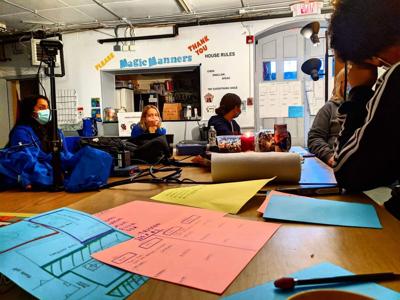HUDSON — Youth department staff members are receiving restorative justice training to change how they approach conflict resolution and to guide others in the city to do the same.
The training has been in development since last year and the program has been growing, Youth Director Nick Zachos said. The staff is being trained by the Newburgh-based Restorative Center.
The department moved $6,750 from other budget lines to pay for the training: $3,283 from youth programs, $2,967 from personnel and $498 from maintenance of Oakdale equipment. The transfer, which was approved by the Common Council, is a result of a discussion at the end of last year to see where money can be moved within the department, Zachos said.
“At the end of the year we go through a process of evaluating what we spend under what lines and what’s remaining,” Zachos said. “We go through this process every year, especially toward the end of the year, evaluating what money we have left in what lines, what we can spend money on and what we can’t.”
Restorative justice is a method of addressing social disconnect, according to the Restorative Center website.
The purpose of restorative justice is to create alternatives to rigid disciplinary systems with pre-written consequences if rules are broken, Zachos said. But black-and-white systems lack nuance.
“What happens is there are actions and there are punishments and very often there is no learning that happens, no righting the wrong in the situation and no empathy in terms of if someone had something wrong done to them,” Zachos said. “So what I look at as the core of restorative justice is taking difficult situations and creating empathy between different parties and learning from the situation.”
The youth department has conducted at least six “restorative circles” over the past six months, two of which were situations when threats of legal action were made, Zachos said. In both situations, participants were satisfied with the result without police or court involvement.
“I think that’s the heart of it,” he said. “Being able to work out issues outside the typical systems, which, while they serve a purpose, they’re not right for every situation.”
A restorative circle is a facilitated discussion with people who are involved with a specific incident, people who can support them and people who may have been affected, Zachos said. Circles are facilitated by someone who has been trained in restorative practices.
“It can be a pretty long process of developing empathy on all sides so everyone can understand why something happened and solutions can be brought up of hopefully how to prevent it from happening again,” he said.
Zachos has seen parents who initially didn’t want to participate ultimately crying and hugging each other after two hours, he said.
Restorative circles are based on Native American and Aboriginal community traditions, according to the Ulster County Restorative Justice and Community Empowerment page. The circle is used to address wrongdoing or harm in a community.
The youth center has turned to restorative circles to address conflict between youth, staff or both, Zachos said. The process allows everyone to be heard and a solution to be reached instead of imposing disciplinary action. Restorative practices have prevented the department from sending youth home on several occasions, he said.
School districts, municipal youth organizations and criminal justice systems have been turning toward the method in the past few years, Zachos said. The youth department has implemented basic practices and wants to continue to educate its staff and train other organizations in Hudson to do the same.
The youth department wants to become a resource for the larger Hudson community and is in conversations with the court system, social services, police department and school district, Zachos said. The goal is for youth staff to train others.
While restorative justice is traditionally thought of in terms of criminals and victims, the youth center is trying to implement the practices in all levels of their work, said Recreation Attendant Jabin Ahmed, who called herself an unofficial restorative justice coordinator for the department. Parts of the department’s handbook have been adjusted to take on the practice.
“Our goal is to establish a set blueprint for the community using restorative justice practices in all organizations, in all institutions,” Ahmed said. “It doesn’t have to be with youth and families.”
As the youth center undergoes renovations, a room is being dedicated to conflict resolution and therapeutic intervention, Ahmed said.









